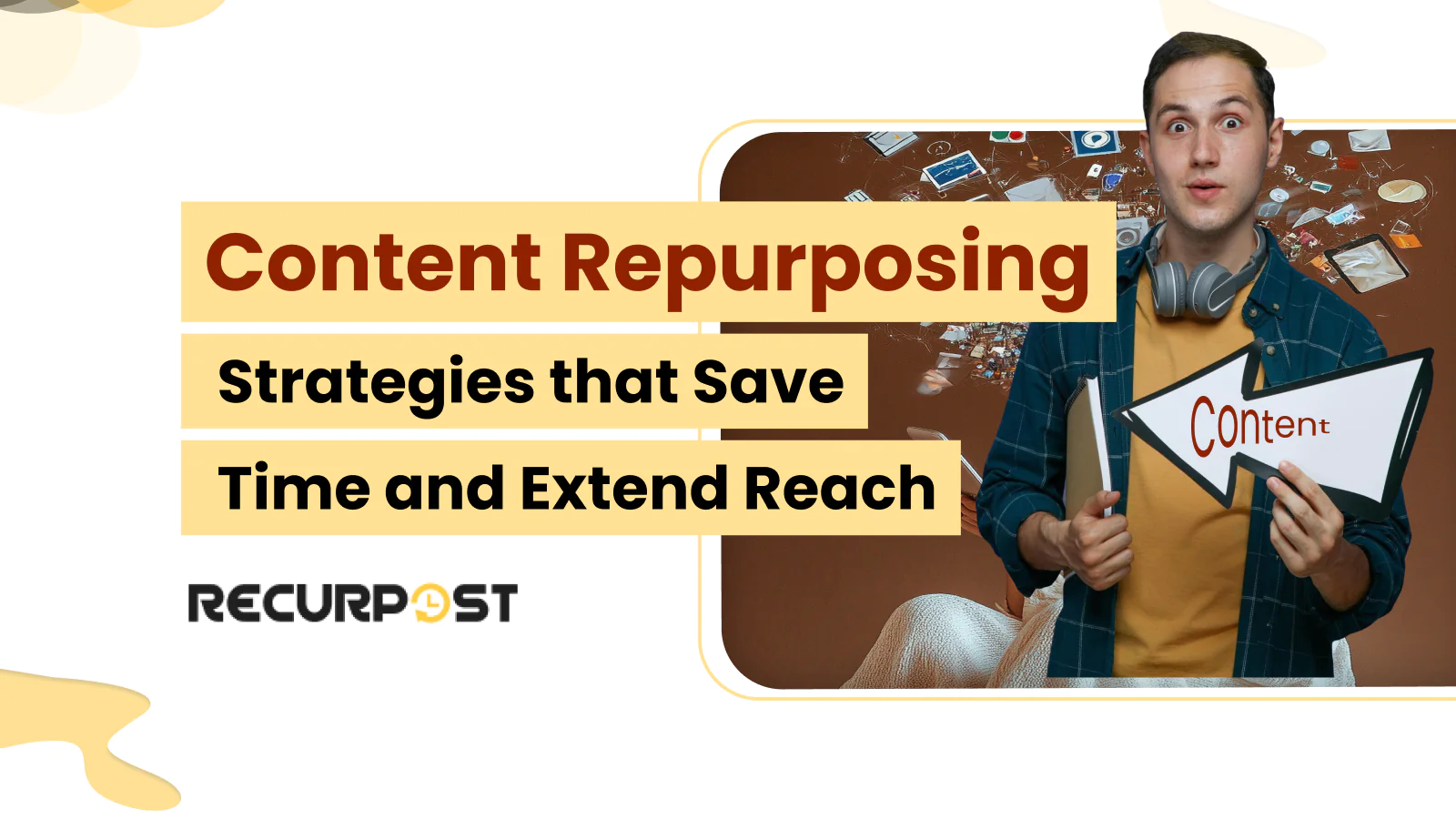Feeling overwhelmed by the constant need for new content? You’re not alone. Whether you manage a social media agency or a small business, the pressure to keep content fresh is real.
But what if you didn’t need to start from scratch every time? Content repurposing is the smart way to take what you’ve already created and give it new life across multiple platforms.
In this guide, we’ll explore how you can develop an effective content repurposing strategy to save time, extend your reach, and get more out of your existing content.
What is Content Repurposing?

Content repurposing is the process of taking your existing content and adapting it into new content formats or for different platforms, which remains one of the best content repurposing strategies for maximizing your content investment. Instead of constantly creating new content, you can breathe new life into your old blog posts, videos, or social media updates by transforming them into something fresh. This approach helps you reach new audiences without the heavy lifting of starting from scratch every time.
If you’re a busy social media content creator, learning how to repurpose blog content for social media is one of the most effective ways to keep your feed active without constant new ideation.
For instance, a high-performing blog post can be transformed into a YouTube video or a series of social media updates or even adapted into a podcast episode. By doing this, you’re maximizing the value of your original work and extending its lifespan across multiple platforms.
Why does this matter? It saves time, keeps your content strategy agile, and ensures you’re consistently engaging your target audience with high-quality, relevant material.
Content Repurposing Statistics
Widespread Adoption: A survey by ReferralRock found that 94% of marketers repurpose their content, with the remaining 6% planning to implement this strategy in the future. [Source: UK Trade & Investment]
The Benefits of Content Repurposing
Content repurposing offers several key benefits that make it a must-have strategy for any social media agency or small business.
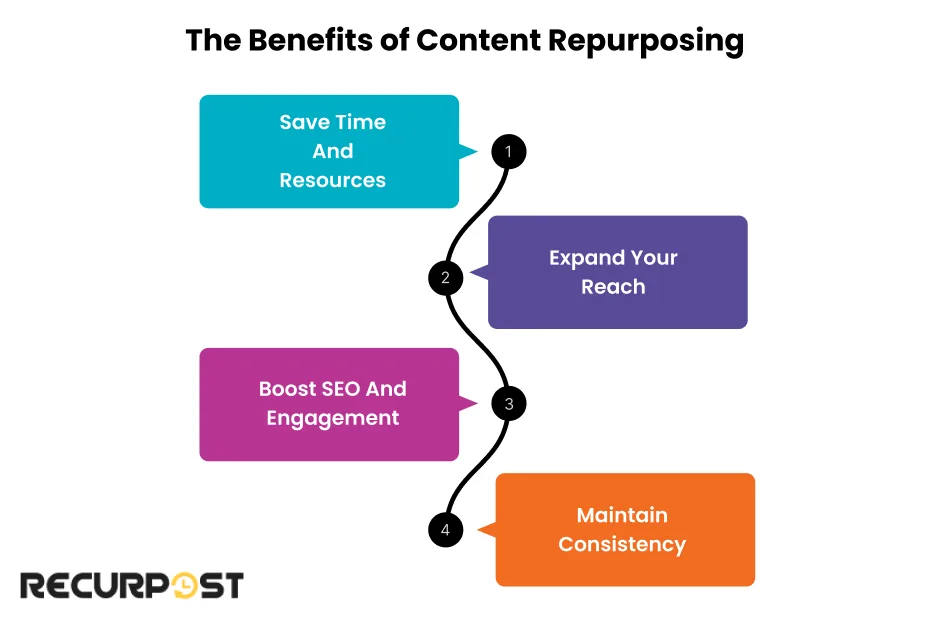
1. Save Time and Resources: By repurposing existing content, you reduce the time and effort needed to constantly produce new content. This allows you to focus more on strategy and less on content creation.
2. Expand Your Reach: When you adapt content for different social media platforms and formats, you tap into new audiences who might prefer consuming content in various ways, like watching a YouTube video or listening to a podcast episode.
3. Boost SEO and Engagement: Repurposing content can enhance your SEO efforts. Creating multiple pieces of content around the same topic helps search engines recognize your authority in that area, potentially boosting your rankings.
4. Maintain Consistency: Repurposing content ensures that your messaging stays consistent across social media channels and platforms, reinforcing your brand identity.
A Step-by-Step Guide to Repurposing Content for Maximum Engagement

Identifying Content Worth Repurposing
Not all content is ideal for repurposing, so how do you choose? Here’s a guide to identifying the best candidates:
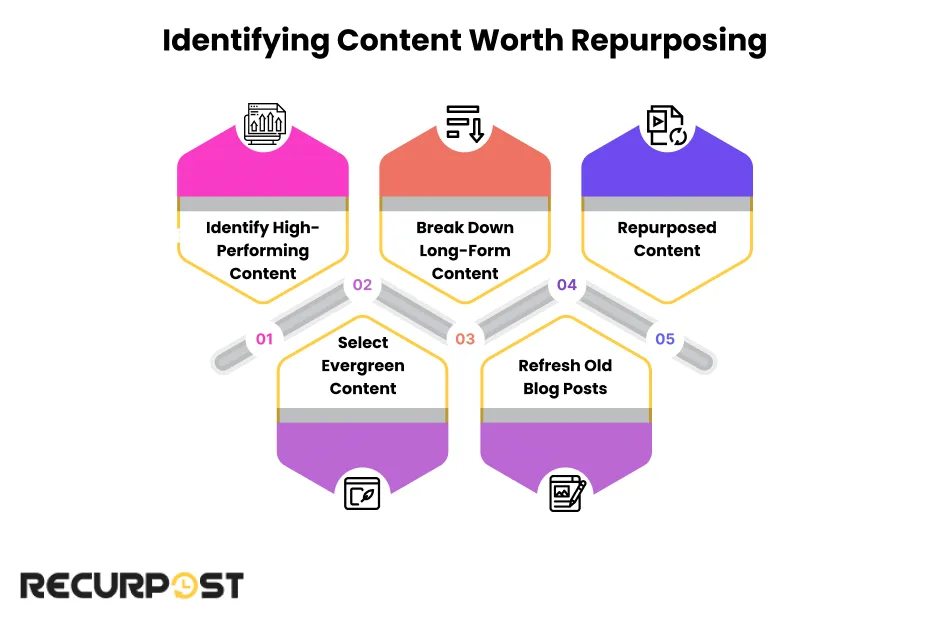
1. High-Performing Content: Start with your high-performing content—these are your blog posts, videos, and social media updates that have already resonated with your audience. Use tools like Google Analytics and Google Search Console to find these pieces.
2. Evergreen Content: Focus on evergreen content marketing—topics that remain relevant over time. These make excellent candidates for repurposing as they have long-term value.
3. Long-Form Content: Long-form blog posts or long-form videos can be broken down into multiple pieces of content for different platforms. For example, a detailed blog can become a series of social media posts or a Slideshare presentation.
4. Old Blog Posts: Don’t forget about old blog posts. They can be refreshed and repurposed into something new, giving them a second life.
For example, a blog post like how to generate content for social media can be repurposed into visual carousels or short videos for Instagram.
Identifying content that fits these categories will help you repurpose content effectively and keep your audience engaged across multiple channels.
Want to repurpose content faster?
Check out how Artificial Intelligence for Social Media can help you turn blogs into social posts, videos, and more—saving time and keeping your content consistent.
Proven Content Repurposing Strategies Examples That Drive Results
Once you’ve identified the content to repurpose, it’s time to put it to work across different platforms. Here are some content repurposing strategies to get started:
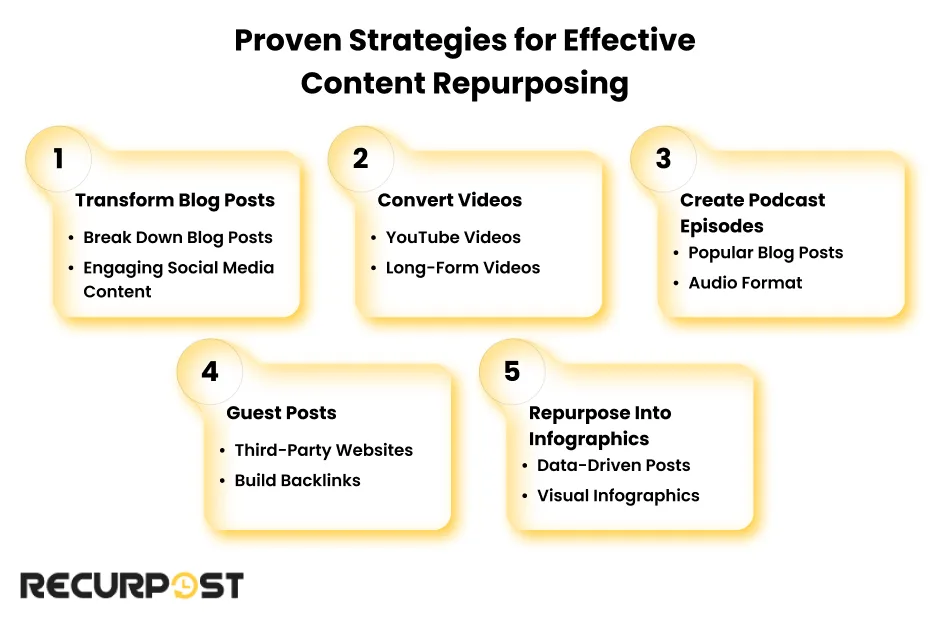
1. Transform Blog Posts into Social Media Content: Learning how to repurpose blog content for social media involves breaking down a detailed blog post into short, engaging content for platforms like Twitter, LinkedIn, or Instagram. This keeps your content engaging and relevant across social media channels.
2. Convert Videos into Blog Posts: If you have a YouTube video or long-form video, turn it into a blog post or article. This gives you a new way to connect with your target audience who might prefer reading over watching.
3. Create a Podcast Episode from a Blog: Take a popular blog post and repurpose it into an audio podcast. This allows you to reach listeners who consume content on the go.
4. Repurpose Content into Infographics: Turn data-driven blog posts or videos into visual content like infographics. This is perfect for sharing on social media platforms like Pinterest or LinkedIn.
5. Guest Posts and Third-Party Websites: Expand your reach by repurposing content into guest posts for third-party websites or blogging platforms. This not only helps you reach new audiences but also builds backlinks for your SEO.
These repurposing content for social media strategies will help you easily transform your high-performing content and ensure you’re getting the most value out of your content creation efforts.
Looking for more ideas? Check out these social media marketing post ideas to inspire your next batch of repurposed posts.
Content Repurposing Tools and Resources for Streamlining Your Strategy
To make content repurposing easier and more efficient, using the right tools is essential. Here are some content repurposing tools that can help:

1. Canva: Ideal for turning blog posts and videos into engaging visual content like infographics and social media graphics.
2. Descript: A powerful tool for editing and transcribing video content and podcast episodes, making it easy to repurpose them into blog posts or articles.
3. RecurPost: These tools allow you to schedule and automate the posting of your repurposed content across various social media platforms, ensuring your content stays active without extra effort.
4. Google Analytics: Use this tool to track the performance of your repurposed content and identify which pieces resonate best with your target audience. It helps you measure the success of your repurposing content efforts.
These tools are designed to help you save time, keep your content creation process organized, and maximize the impact of your repurposed content.
If you’re building a long-term content schedule, explore RecurPost’s social media content planner to keep your plan organized.
How to Repurpose Content Effectively Using RecurPost
RecurPost is an excellent tool for automating and streamlining your content repurposing efforts. Here’s how to repurpose content effectively with RecurPost:
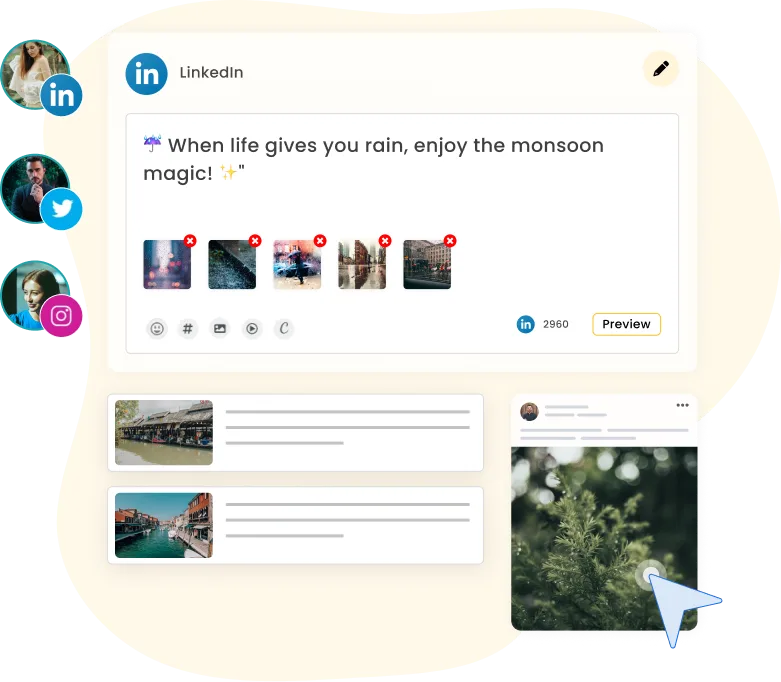
1. Import and Recycle Content: RecurPost allows you to import your existing content from social media platforms, blogs, and other sources. Once imported, you can set up recurring schedules to repost this content over time, ensuring it remains visible and continues to engage your audience.
2. Create Content Libraries: Organize your high-performing content into libraries. RecurPost will cycle through these libraries, automatically sharing posts according to the schedule you set, maximizing exposure without additional effort.
3. Custom Scheduling: Tailor your posting schedule for different social media channels. You can choose specific times and days for each platform to optimize when your target audience is most active.
4. Track Performance: RecurPost provides analytics to help you monitor the success of your repurposed content. This insight allows you to refine your strategy and focus on what works best.
Using RecurPost simplifies the process of content recycling and ensures that your old content continues to deliver value long after its original post date.
For more details on how to get started, check out [RecurPost].
Best Practices for Successful Content Repurposing
To get the most out of content repurposing, following best practices is crucial:
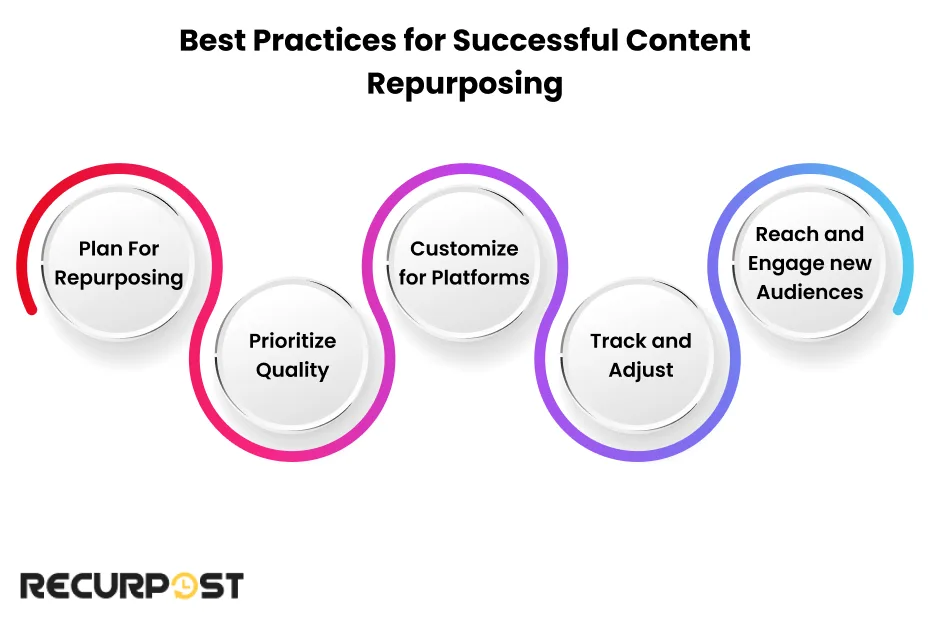
1. Plan Repurposing from the Start: When you create content, consider how it can be repurposed across multiple platforms. For example, think about how a long-form blog post could be broken down into social media posts or a YouTube video.
2. Prioritize Quality: While it’s tempting to churn out multiple pieces from one source, always prioritize high-quality content. Ensure that each piece adds value and meets the expectations of your target audience.
3. Customize for Platforms: Tailor your repurposed content to fit the unique requirements of each platform. For instance, a visual-heavy approach might work better on Instagram, while LinkedIn might require a more formal tone.
4. Track and Adjust: Monitor and refine your strategy by using tools like Google Analytics to track how your repurposed content performs. Analyze what’s working and tweak your strategy to better meet your goals.
By incorporating these practices, you can ensure that your repurposing efforts are not just efficient but also effective in reaching and engaging new audiences.
Need a starting point? Try using this sample social media calendar to structure your content rollout.
How Long Before You Can Repurpose Content?
You can repurpose content almost immediately after it has been published, but the timing depends on your goals and strategy. Here are some scenarios to guide you:
Immediate Repurposing (Days to Weeks After Publishing)
- Cross-Platform Sharing: Repurpose a blog post into social media snippets, infographics, or a quick video.
- Audience Segmentation: Adapt content to target different audience groups.
- Trending Topics: If the content aligns with current trends, repurpose it right away to maximize visibility.
For instance, if your blog post ties into a holiday, consider using this April social media holidays guide to align your repurposing schedule.
Mid-Term Repurposing (1-3 Months After Publishing)
- Performance Analysis: Use analytics to identify top-performing content. Repurpose it into different formats like podcasts, webinars, or case studies.
- Seasonal Updates: Modify content to align with upcoming seasons, events, or campaigns.
Long-Term Repurposing (6-12 Months After Publishing)
- Evergreen Content: Update and repurpose evergreen posts to keep them relevant.
- Content Refresh: Add new data, visuals, or insights to older posts for re-publishing.
- Compilations: Combine multiple related pieces into an eBook, guide, or white paper.
The key is to analyze the content’s relevance and performance before repurposing. High-performing, evergreen, or trending content is best suited for quick repurposing, while older content can be updated and reused strategically.
Content Repurposing Examples
To see content repurposing in action, let’s look at some real-world content repurposing examples:
1. Moz’s Whiteboard Fridays: Moz takes its Whiteboard Friday videos and repurposes them into blog posts with video transcriptions, visuals, and key takeaways. This strategy not only enhances SEO but also caters to audiences who prefer reading over watching.

2. Gary Vaynerchuk’s Content Model: Gary Vaynerchuk often repurposes a single keynote speech into multiple pieces of content—videos, blog posts, social media snippets, and even podcast episodes. This ensures his content reaches audiences on different platforms.
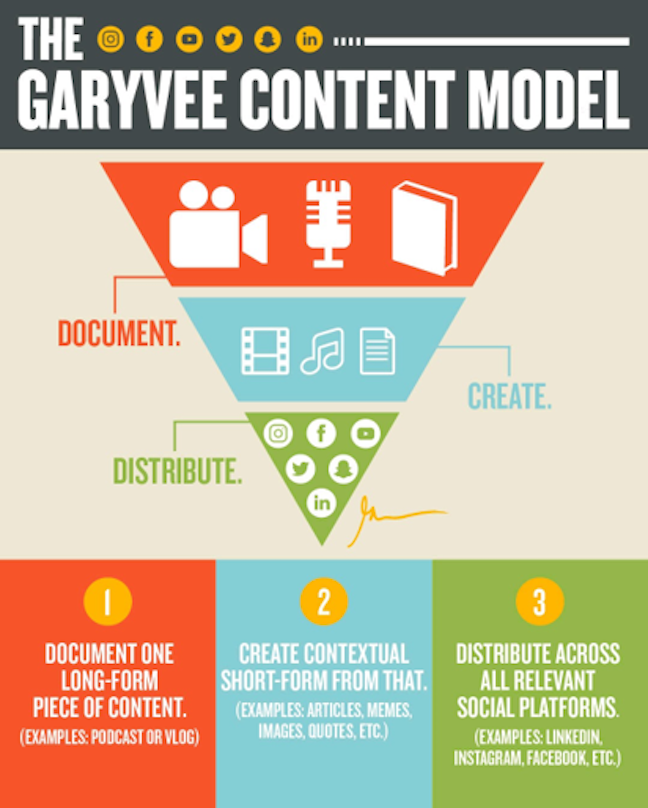
3. TED Talks: TED Talks are a prime example of content repurposing. Each talk is turned into a YouTube video, blog post, social media content, and sometimes even book. This multi-format approach helps TED engage a global audience effectively.

These examples illustrate how repurposing content can amplify your reach and enhance the effectiveness of your marketing efforts.
Overcoming Common Challenges in Content Repurposing
While developing a content repurposing strategy can be incredibly effective, it comes with its own set of challenges that need to be addressed systematically. Here’s how to overcome content repurposing problems:
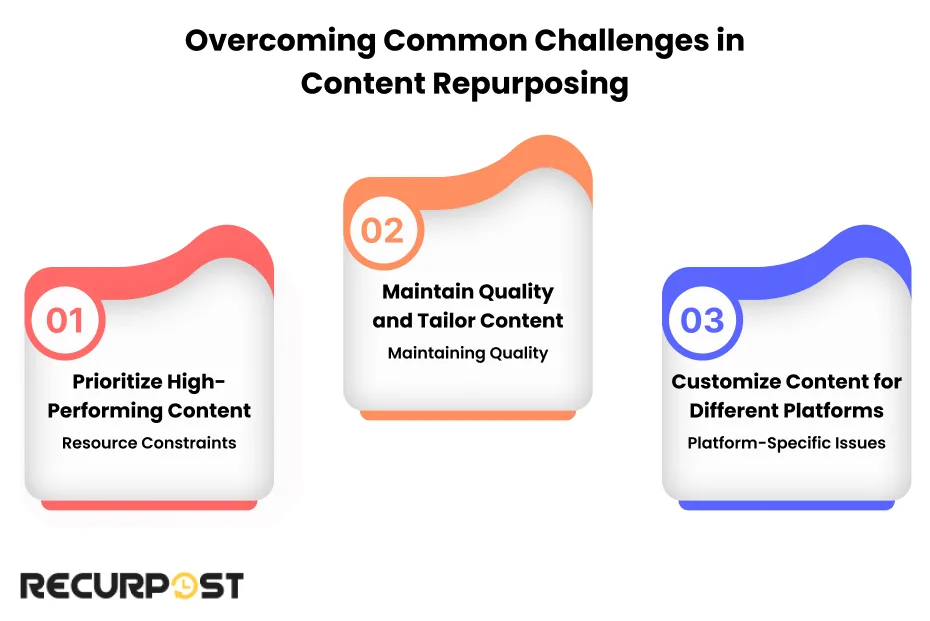
1. Resource Constraints: When resources are limited, prioritize high-performing content for repurposing. Focus on pieces that have already shown strong engagement.
2. Maintaining Quality: It’s crucial to keep the quality high when repurposing content. Always ensure that your repurposed pieces offer value and are tailored to the specific social media platforms or formats.
3. Platform-Specific Issues: Different platforms require different approaches. For example, content that works on LinkedIn might need to be visually enhanced for Instagram. Customize your content to fit the platform’s unique audience and format.
By addressing these challenges head-on, you can ensure your repurposing efforts are both effective and sustainable.
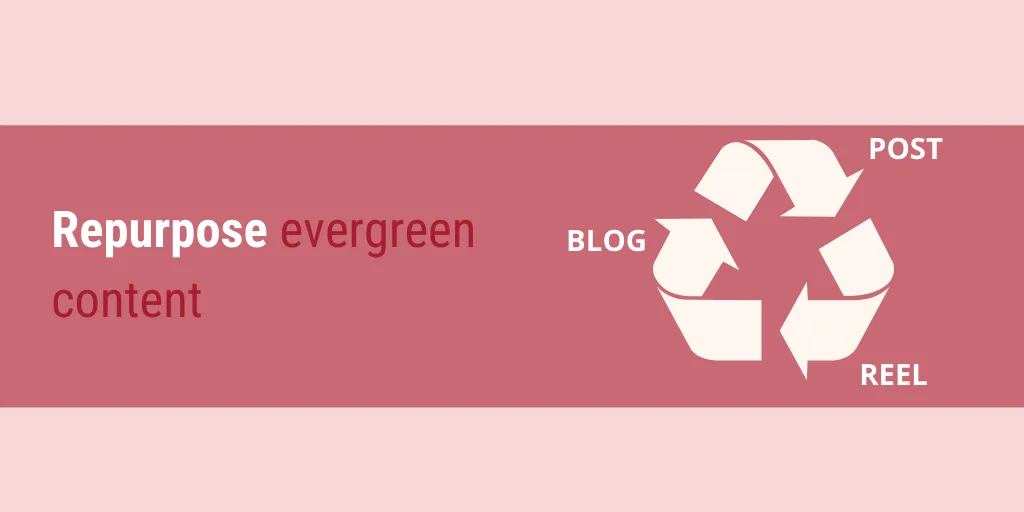
Conclusion
Content repurposing is a powerful strategy for maximizing the value of your existing content. By transforming blog posts, videos, and other materials into different formats, you can reach new audiences across multiple platforms without constantly creating from scratch.
It’s about working smarter, not harder.
Start by identifying high-performing and evergreen content, and use the strategies and tools discussed to keep your content fresh and engaging. Remember, every piece of content you create has the potential for a second life.
A Step-by-Step Guide to Repurposing Content for Maximum Engagement

Frequently Asked Questions
1. How often should I repurpose content?
Regularly review your existing content to identify pieces that can be repurposed. A good rule of thumb is to update and repurpose content every few months.
2. What are the best platforms for specific content types?
Blog posts work well on LinkedIn and Medium, while videos excel on YouTube and Instagram. Infographics are perfect for Pinterest and LinkedIn.
3. Can content repurposing harm SEO?
No, as long as you avoid duplicate content issues and ensure that each repurposed piece is unique and valuable.
4. How do I measure the success of my repurposed content?
Use tools like Google Analytics to track engagement, traffic and conversion rates for your repurposed content. Monitor how well the repurposed pieces perform compared to the original.
5. Is there a limit to how many times I can repurpose the same content?
There’s no strict limit, but it’s important to ensure that each repurposed piece offers something new and valuable. Avoid repeating the same content in the same format too frequently, as this can lead to audience fatigue.
6. How do I choose the right format for repurposed content?
Consider your target audience and the platform. For example, visual content like infographics works well on Instagram, while detailed blog posts are better suited for LinkedIn or your website.

Saurabh Chaturvedi is a content writer at RecurPost. Specializing in social media management and marketing, Saurabh is dedicated to crafting engaging and informative articles. His passion for clear, exciting content keeps readers eager for more.
